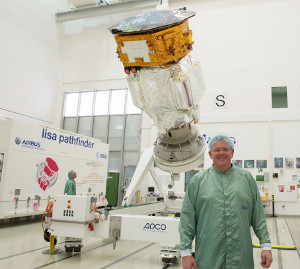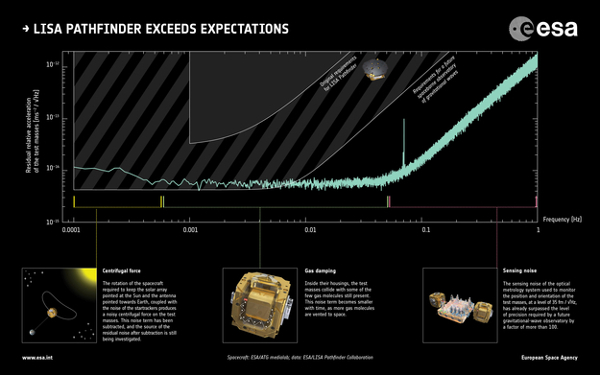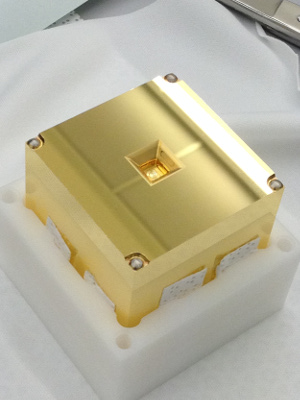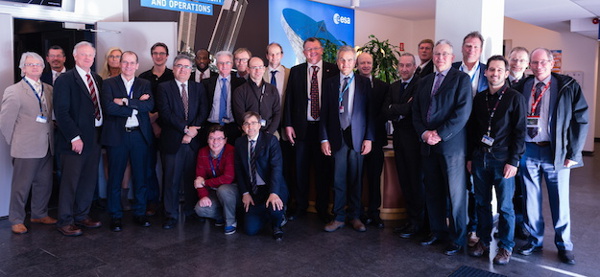LISA Pathfinder – not resting on its laurels
 |
| Paul McNamara pictured with the LISA Pathfinder spacecraft. Credit: ESA–P. Sebirot, 2015 |
"We got the spacecraft up there and it worked perfectly. It's been delightful," says Paul.
"The whole point of Pathfinder is that people didn't believe we could ever build LISA; the whole thing was so difficult that you'd better build this little test first. And the point was to make the test a factor of ten less sensitive than you need for the big mission, but that's all we would need because it's a demonstration.
"Then the very first time we turned it on to look at its performance, we met all the requirements. And that to me was just stunning."
While the successful performance of the spacecraft was great news for the team, their first reaction was not to rest on their laurels but to build on what had been achieved, to push the limits. Their ambitions switched from meeting the LISA Pathfinder requirements to showing what could be done for the future observatory mission.
"We actually don't even draw the Pathfinder requirements now on the plot because there's too much white space! We just compare ourselves to what we need for the big mission, for LISA – now we're a factor of two better all over and at high frequencies we're a factor of 30-or-so better. The whole thing has just come together brilliantly."
 |
| LISA Pathfinder performance. Copyright: spacecraft: ESA/ATG medialab; data: ESA/LISA Pathfinder Collaboration |
Somehow, after years of frustration, delays, redesigns, and hard work, the team had suddenly made it look easy. But the demands of LISA Pathfinder were anything but easy to meet.
 |
| LISA Pathfinder test mass. Credit: CGS SpA |
"If you take a sample test mass – one of the small metal alloy cubes in the spacecraft – and put it sitting on a surface it looks as if it's not moving, but it's moving probably a hundred thousand to a million times more than the Pathfinder spacecraft at the frequencies we're interested in," Paul says – pointing at a model test mass on his desk.
The engineering required to fly the test masses so that the only force acting on them was gravity was extremely complex. Every possible force on the spacecraft had to be measured, right down to the mass of every component aboard, and that meant knowing every millimetre of the machine.
"When the spacecraft was integrated, for example, you've got to tie down the harness of cabling, so you get a cable tie, and take the mass of the cable tie, which is a bit of plastic, and tie down whatever bit you were going to tie down. Then you cut the leftover bit of cable tie off and measure the mass of that piece to know what's left on the spacecraft.
"So at Astrium – Airbus as it is now – they had thousands of entries logging everything on the spacecraft: where its position was, and exactly the mass that was left in it. That all went into the computer model. It's a very complicated model, although it's fairly simple physics, if you know Newton's law, but you have to know exactly where everything is and the mass of it," Paul says.
As LISA Pathfinder drew close to its launch date, rumours suddenly pervaded the physics world that a gravitational wave detection had been made on the ground. The Advanced LIGO detectors in the United States has just been upgraded and had made a detection almost immediately upon returning to operation. While the international team crunched the numbers to prove it, the LISA Pathfinder team was fielding questions about whether gravitational waves were even out there to be found.
"I was absolutely delighted at the news! It was hard, you know, because it happened on 14 September (before the launch of LISA Pathfinder). Everybody in this field of science, certainly of my age, has worked on both ground-based and space-based gravitational-wave detectors – I worked on LIGO, GEO, and LISA at the same time.
"And some of the people are part of both LISA and LIGO teams, people like Karsten Danzmann, so of course he knew it was there, it was real. He couldn't tell us – couldn't tell anyone. But then you go to the launch of LISA Pathfinder and people were saying 'Do you think you'll ever find a gravitational wave?' and we had to sit there and say 'Oh, well, I don't know, you know, I think we're getting there.'"
The publicity surrounding the detection emphasised that "Einstein was right", but a whole generation of living scientists had had their work vindicated.
"I'm young, I've only been working on it for 23 years now, on LISA and gravitational waves. My old boss, Jim Hough, he was working on it from before I was born, trying to find these things. So it was just amazing, to think that you can build an instrument with such a high precision that you can measure the Universe shaking.
"It's not a wave going through the Universe, it's the Universe itself. You can't surf it – that's a question you get quite often: could you use it for propulsion? The answer is no, because it's not something moving through the Universe, it is the Universe moving. It's the whole of space-time."
The black-hole merger detected by the LIGO-Virgo consortium in September 2015, and published in February 2016, has experts puzzled. The first detected source in the new field of gravitational wave astronomy does not quite fit what should be going on in the Universe at that age.
"Because there was no theory from physics, astronomy, or cosmology, that allowed this size of object – a black hole of about 30 times the mass of the Sun – to exist at such a late time in the Universe, 1.3 billion years ago, you go to a conference and you get ten people standing up giving you their favourite theory of how this thing came to be. And then you go to the next conference and nine out of ten of those theories have been wiped out and there's another ten people with ten more theories. It's wonderful! You really are at the first step of a completely new world, with people trying to understand a whole new aspect of what's out there."
Already there have been two more detections of gravitational waves, announced by the LIGO team on 15 June 2016 and 1 June 2017. The ground-based system will add new data over the coming years, as more detectors are built and existing ones improved, but a space-based gravitational wave observatory will give a whole new perspective.
"It's really ramped up in a very short time. In October 2016 the call went out for concepts for L3 – the third large mission in ESA's Science Programme. A proposal was delivered in January 2017, and then we had a CDF (Concurrent Design Facility) study starting in March. It's going so quickly. And it's all to do with the fact that Pathfinder was such a resounding success and now we know that gravitational waves are out there and we can find them; it's a whole new astronomy.
"Because of the frequencies that it is sensitive to, the future LISA mission will detect gravitational waves long before those on the ground – it could work to alert the ground-based detectors to upcoming events. And while the aim would be to match events detected with light – at some wavelength in the electromagnetic spectrum – to gravitational wave observations, the intervening matter could easily delay either signal by thousands of years."
The new astronomy that awaits a space-based gravitational wave observatory seems within touching distance now. But there were many obstacles for LISA Pathfinder – times where the technology required by the mission seemed almost too difficult and the schedule slipped.
"The thing that was hardest in the life of Pathfinder was when flight hardware would fail testing," says Paul. "Then, you're really close to the end and suddenly it all just goes belly up and you don't know 'Is it solvable? Is it not solvable? Is this it? Are you going to be cancelled at this point because it's going to take another two years to make something?' And that can get… depressing is probably too strong a word, but it gets you down." Despite such difficult times, the LISA Pathfinder team hung in and were determined to launch and operate a successful mission – which they did.
Now, with the end of the mission in sight, it's a poignant time for the team, but also a time to look ahead with anticipation.
 |
| Paul with members of LISA Pathfinder teams and the mission review panel, pictured at ESTEC on 7 March 2015, after the formal review of the LISA Pathfinder commissioning. Credit: ESA–C.Carreau |
"On 20 June the LISA mission was selected by ESA's Science Programme Committee, to be the third large science mission in the Science Programme.
"And only a short time later, on 30 June, Pathfinder ends its science mission. After we've made sure it's decommissioned properly – that we've got transponders and everything switched off – then we'll send the final command in July. So just as Pathfinder is ramping down, LISA is taking off. It's perfect timing!"
